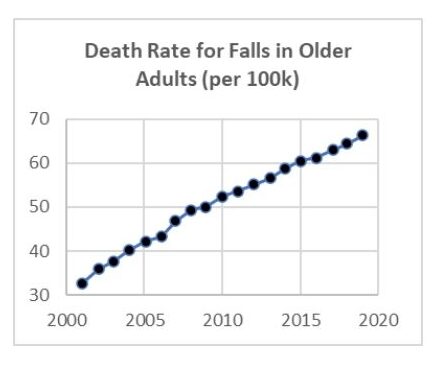
Introduction
The Department of Rehabilitation Sciences at Hong Kong University recently published a study on the importance of dual-tasking in gait rehabilitation, with a specific focus on improving dynamic balance and reducing falls in older adults
Their systematic review delves into the complex realm of falls prevention among older adults, a significant global health concern due to its association with morbidity, mortality, and diminished quality of life. This is especially critical as the per capita rate of fall injuries and mortality from fall injuries continues to rise out of control (see figures on the right), even as numerous organizations invest resources and technology into solving this issue.
While falls is now well-understood to be driven by a decline in executive function, this review focused on the ability for dual-tasking (DT) to resolve balance impairment.


Dual Task Training: Theory
This review highlighted the growing literature on dual-task (DT) training, where individuals simultaneously perform a primary motor task along with a secondary cognitive task. This approach mirrors real-life scenarios where daily activities often require concurrent motor and cognitive engagement. Over the past two decades, there has been an increasing interest in DT training as a strategy to improve balance and reduce falls among older adults. Studies employing DT paradigms have explored various theories underlying its effectiveness, ranging from attention theory to multicomponent training approaches.
The attention theory, a dominant explanation in the literature, posits that DT training enhances balance by improving attention-shifting abilities between tasks. This theory suggests that as individuals engage in DT exercises, they develop the capacity to efficiently allocate attention to multiple stimuli, thereby improving their balance control. Other theories, such as executive function, working memory, and cognitive flexibility, also contribute to our understanding of how DT interventions improve balance by targeting specific cognitive processes essential for motor control and coordination.

Systematic Review of Dual-Task Training Studies
The review systematically examined 30 randomized controlled trials (RCTs) focusing on older adults without pathological conditions, aiming to elucidate the underlying theories driving the effectiveness of DT training in improving balance and reducing falls. It is important to note that by limiting this meta-analysis to only RCTs, any conclusions can be assured of having been based on high-quality evidence.
The meta-analysis included a comprehensive overview of the types of DT interventions, exercise modalities, dosages, and outcome measures employed across the included studies. Notably, motor-cognitive DT training emerged as a prevalent approach, emphasizing the integration of motor tasks with cognitive challenges to enhance balance and reduce falls risk.
Of the 30 RCTs on DT, 26 reported improved balance and 5 studies found a reduction in fall incidence following DT training. Balance and falls improved significantly in 15 motor-cognitive DT intervention studies.
Conclusion
This study continues to add to the increasing body of meta-analyses that conclusively demonstrate superior outcomes when comparing dual-task training to traditional single-task exercises. This includes significant improvements in walking speed, step and stride length, TUG, attention, executive function, and functional and dynamic balance among Parkinson’s patients (Lopez, et. al., 2023 and Wong et. al., 2023 and Du et. al., 2022) and significant improvements in step length, cadence, stride length, 10MWT, and functional balance among stroke patients (Zhang et. al., 2022 and Shu et. al., 2022). Notably, significant improvements in gait parameters, such as walking speed, step and stride length, alongside cognitive gains in attention and executive function, underscore the comprehensive benefits of dual-task training.
The evidence presented aligns with the innovative approach of GaitBetter, which is specifically designed to facilitate motor-cognitive dual-tasking in a controlled, engaging, and interactive environment. GaitBetter’s integration into rehabilitation practices offers a practical application of the dual-tasking theory, providing a structured platform for implementing these beneficial training protocols. By simulating real-life scenarios that require simultaneous cognitive and physical engagement, GaitBetter not only addresses the findings from these studies but also offers a scalable and effective solution to improve balance and reduce fall risk among older adults and other populations in need.
In essence, the systematic review’s findings on the efficacy of dual-task training in fall prevention and balance improvement strongly advocate for the adoption of technologies like GaitBetter. It emphasizes the critical need for rehabilitation programs to incorporate dual-task training as a central component of their intervention strategies. As we move forward, further research into optimizing dual-task training modalities, including the use of innovative technologies like GaitBetter, will be essential to advance clinical practices and promote healthy aging effectively.

